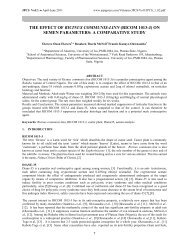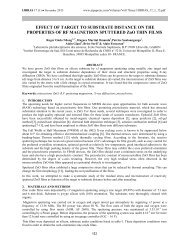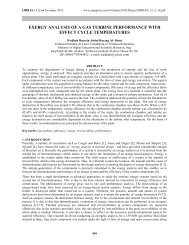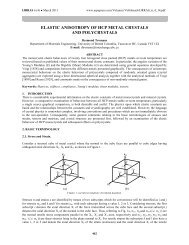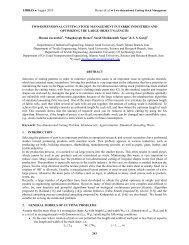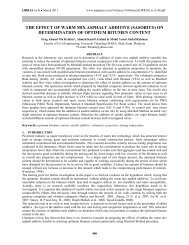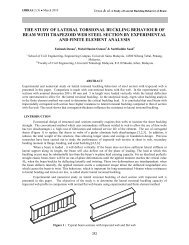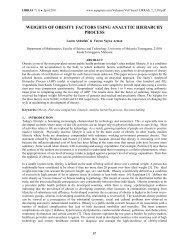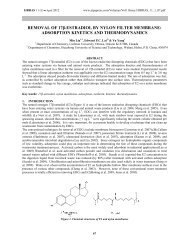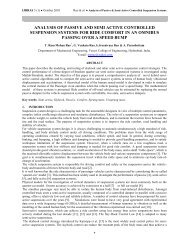epidermal micromorphology of species in the genus ...
epidermal micromorphology of species in the genus ...
epidermal micromorphology of species in the genus ...
You also want an ePaper? Increase the reach of your titles
YUMPU automatically turns print PDFs into web optimized ePapers that Google loves.
JPCS Vol(3) ● Oct-Dec 2011<br />
www.arpapress.com/Volumes/JPCS/Vol3/JPCS_3_04.pdf<br />
EPIDERMAL MICROMORPHOLOGY OF SPECIES IN THE GENUS<br />
CRASSOCEPHALUM MOENCH .S. MOORE (COMPOSITAE) IN<br />
NIGERIA<br />
Kemka, C.I. 1 & Nwachukwu, C.U. 2<br />
Department <strong>of</strong> Biology, Alvan Ikoku Federal College <strong>of</strong> Education Owerri, Imo State, Nigeria<br />
ABSTRACT<br />
Detailed studies on eight Crassocophalum <strong>species</strong> ( biafrae, C. montuosum, C. mannii, C. crepidioides C.<br />
vitell<strong>in</strong>um, C. rubens, C.togoense and C. sarcobasis) found <strong>in</strong> Nigeria, which are important leaf vegetables were<br />
undertaken with <strong>the</strong> aid <strong>of</strong> a microscope to ascerta<strong>in</strong> <strong>the</strong>ir taxonomic relationship. The micromorphological features<br />
discovered <strong>in</strong>clude <strong>the</strong> hypostomatic distribution <strong>of</strong> stomata <strong>in</strong> C. mannii while <strong>the</strong> o<strong>the</strong>r <strong>species</strong> had<br />
hypoamphistomatic. S<strong>in</strong>uous anticl<strong>in</strong>al wall was present on adaxial (upper) surfaces <strong>of</strong> C. togoense and<br />
C.crepidioides, <strong>the</strong> clusters <strong>of</strong> trichomes on mid-ve<strong>in</strong> <strong>of</strong> <strong>the</strong> adaxial surfaces <strong>of</strong> C.vitell<strong>in</strong>um and C.<br />
crepidioides.The high density <strong>of</strong> trichomes on <strong>the</strong> ve<strong>in</strong>s <strong>of</strong> <strong>the</strong> adaxial surface <strong>of</strong> C.mannii is <strong>of</strong> taxonomic <strong>in</strong>terest<br />
and could be used to demilit <strong>the</strong> taxon from <strong>the</strong> o<strong>the</strong>r <strong>species</strong>. C.vitell<strong>in</strong>um, C.crepidioides and C. togoense which<br />
are densely hairy could also be delimited from C.biafrae and C.montuosum that are sparsely hairy.A mixture <strong>of</strong><br />
s<strong>in</strong>uous and straight-arcuate anticl<strong>in</strong>al wall was present <strong>in</strong> both <strong>the</strong> abaxial and adaxial surfaces <strong>of</strong> all<br />
crassocephalum <strong>species</strong> studied except <strong>in</strong> C.togoense and C.crepidioides that has s<strong>in</strong>uous anticl<strong>in</strong>al wall <strong>in</strong> both<br />
adaxial and abaxial surfaces.<br />
Keywords. Crassocephalum , Micromorphology, Epidermis,Adaxial,Abaxial.<br />
1. INTRODUCTION<br />
The <strong>genus</strong> Crassocephulum Moench S. Moore is a member <strong>of</strong> <strong>the</strong> tribe Senecioneae <strong>in</strong> Compositae (Asteraceae)<br />
family. The family is cosmopolitan <strong>in</strong> distribution and <strong>in</strong> West Africa conta<strong>in</strong>s about 84 genera and 288 <strong>species</strong><br />
(Gill, 1988). The members <strong>of</strong> <strong>the</strong> genera are mostly herbs and rarely shrubs. Crassocephalum is represented by<br />
twenty four <strong>species</strong> <strong>in</strong> Tropical Africa ( Bosch, 2004 ) and fifteen <strong>species</strong> <strong>in</strong> West Africa <strong>in</strong> which ten <strong>species</strong> have<br />
been recorded <strong>in</strong> Nigeria (Hutch<strong>in</strong>son and Dalziel, 1963). Crassocephalum, which is <strong>in</strong> <strong>the</strong> same tribe as Emilia,<br />
have <strong>the</strong>ir <strong>in</strong>volucral bracts be<strong>in</strong>g <strong>in</strong> only one series (Olorode, 1984).The <strong>species</strong> <strong>of</strong> <strong>the</strong> <strong>genus</strong> Crassocephalum are<br />
<strong>of</strong> various economic values. C. crepidioides is a herb <strong>of</strong>ten cultivated <strong>in</strong> Sour<strong>the</strong>rn Nigeria and are used as<br />
vegetables. In Kenya donkeys are reported to browse C. montuosum and <strong>in</strong> (Tanganyika) Tanzania <strong>the</strong> plant is used<br />
for treat<strong>in</strong>g <strong>in</strong>fected eyes.The importance <strong>of</strong> <strong>epidermal</strong> characters <strong>in</strong> general and those <strong>of</strong> trichome <strong>in</strong> particular has<br />
been widely recognized <strong>in</strong> angiospermic taxonomic consideration by workers such as (Ogundipe,<br />
1992),(Nwachukwu and Edeoga, 2006) <strong>in</strong> eight <strong>species</strong> <strong>of</strong> Indig<strong>of</strong>era Legum<strong>in</strong>osae- Papilionideae. (Mbagwu,<br />
Nwachukwu and Okoro, 2008) <strong>in</strong> two <strong>species</strong> <strong>of</strong> Solanum (Solanaceae),(Edeoga and Ikem 2001) <strong>in</strong> three <strong>species</strong> <strong>of</strong><br />
Boerhevia (Nyctag<strong>in</strong>aceae). Accord<strong>in</strong>g to <strong>the</strong>m majority <strong>of</strong> <strong>the</strong> flower<strong>in</strong>g plants can readily be identified with as<br />
much ease by <strong>the</strong>ir vegetative characters as by <strong>the</strong>ir floral structure.Consider<strong>in</strong>g <strong>the</strong> various uses <strong>of</strong> Crassocephalum<br />
plants and <strong>the</strong> paucity <strong>of</strong> <strong>in</strong>formation on <strong>the</strong> <strong>epidermal</strong> studies, this paper <strong>the</strong>refore describes <strong>the</strong> <strong>epidermal</strong><br />
micromorphological characters <strong>of</strong> <strong>species</strong> <strong>in</strong> <strong>the</strong> <strong>genus</strong> Crassocephalum<br />
2. MATERIALS AND METHODS<br />
Fresh and mature leaves were collected from randomly selected plants <strong>of</strong> <strong>species</strong> studied. The specimens were fixed<br />
<strong>in</strong> F.A.A. (formal<strong>in</strong> acetic acid alcohol mixture) for 48 hours to ensure that <strong>the</strong> cells are possibly ma<strong>in</strong>ta<strong>in</strong>ed as near<br />
to life and improve <strong>the</strong> contrast. Herbarium materials were first boiled for about 10 m<strong>in</strong>utes to s<strong>of</strong>ten it before fix<strong>in</strong>g<br />
<strong>the</strong>m. After 48 hours <strong>the</strong> fixed materials were r<strong>in</strong>sed with distilled water and soaked <strong>in</strong> 5% commercial bleach<br />
(Sodium Oxochlorate II (Nacl) for about 20 m<strong>in</strong>utes to lubricate and s<strong>of</strong>ten <strong>the</strong> tissues <strong>of</strong> <strong>the</strong> leaves. The surface to<br />
be exam<strong>in</strong>ed was placed on a glass slide while <strong>the</strong> o<strong>the</strong>r surface was carefully scraped with a razor blade. The clear<br />
<strong>epidermal</strong> layers obta<strong>in</strong>ed were <strong>the</strong>n washed <strong>in</strong> several changes <strong>of</strong> distilled water, sta<strong>in</strong>ed <strong>in</strong> 1% safran<strong>in</strong> – 0 for<br />
about 1 m<strong>in</strong>ute and temporary mounted <strong>in</strong> aqueous glycerol solution.<br />
29
JPCS Vol(3) ● Oct-Dec 2011<br />
Kemka & Nwachukwu ● Species <strong>in</strong> <strong>the</strong> Genus Crassocephalum<br />
3. RESULTS<br />
The <strong>epidermal</strong> cell and stomatal characteristics <strong>of</strong> <strong>the</strong> taxa <strong>in</strong>vestigated are shown <strong>in</strong> Tables 1 and 2. The taxa<br />
studied showed s<strong>in</strong>uous anticl<strong>in</strong>al walls on all <strong>the</strong> abaxial surfaces. (Plates 9,10,11,12,13,and 14). S<strong>in</strong>uous anticl<strong>in</strong>al<br />
wall also occurred on <strong>the</strong> adaxial surfaces <strong>of</strong> C. togoense and C. crepidioides (Plates 3 and 8). The anticl<strong>in</strong>al wall is<br />
straight to arcuate on <strong>the</strong> adaxial surfaces <strong>of</strong> C. mannii, C. biafrae, C. vitell<strong>in</strong>um, C. montuosum and C. crepidioides<br />
(Plates 1, 2, 3, 4, 5, 6, 7 and 8).<br />
Cuticular striations appeared on <strong>the</strong> abaxial surfaces <strong>of</strong> C. montuosum C. vitell<strong>in</strong>um and C. crepidioides. There are<br />
four to five <strong>epidermal</strong> cells around <strong>the</strong> stomata on both <strong>the</strong> adaxial and abaxial surfaces <strong>in</strong> all <strong>the</strong> <strong>species</strong> studied.<br />
The distribution <strong>of</strong> <strong>the</strong> stomata is hypoamphistomatic <strong>in</strong> all <strong>the</strong> <strong>species</strong> except C. mannii which is hypostomatic.<br />
Contiguous stomata were found <strong>in</strong> <strong>the</strong> abaxial and adaxial surface <strong>of</strong> all <strong>the</strong> taxa studied viz. C. biafrae, C.<br />
montuosum, C. mannii, C. crepidioides C. vitell<strong>in</strong>um, C. rubens, C.togoense and C. sarcobasis. Anomocytic stomata<br />
were found on both adaxial and abaxial surfaces <strong>of</strong> all <strong>the</strong> <strong>species</strong> studied. Anisocytic stomata were found on <strong>the</strong><br />
adaxial surface <strong>of</strong> C. vitell<strong>in</strong>um, C. biafrae and C. sarcobasis.<br />
TRICHOMES:<br />
Simple unbranched, non glandular trichomes occurred on all <strong>the</strong> taxa studied. The occurrence is more on <strong>the</strong> abaxial<br />
surfaces than <strong>the</strong> adaxial surface. The mid-ve<strong>in</strong> <strong>of</strong> <strong>the</strong> adaxial surfaces <strong>of</strong> C. mannii showed clusters <strong>of</strong> <strong>the</strong>se simple<br />
unbranched non-glandular trichomes. In terms <strong>of</strong> density <strong>of</strong> <strong>the</strong> trichomes, <strong>the</strong> results <strong>in</strong>dicated that C. vitell<strong>in</strong>um, C.<br />
crepidioides, C. sarcobasis and C. togoense are densely hairly while C. biafrae and C. montuosum are sparsely<br />
hairy.<br />
30
JPCS Vol(3) ● Oct-Dec 2011<br />
Kemka & Nwachukwu ● Species <strong>in</strong> <strong>the</strong> Genus Crassocephalum<br />
TABLE 1: EPIDERMAL CELL CHARATERISTCIS OF THE CRASSOCEPHALUM SPECIES STUDIED<br />
Character Epidermal Anticl<strong>in</strong>al Epidermal Cell Length Epidermal Cell<br />
Cell Shape Cell Wall<br />
Width<br />
Species<br />
C. mannii<br />
Abaxial Surface<br />
Adaxial Surface<br />
C. biafrae<br />
Abaxial Surface<br />
Adaxial Surface<br />
C. crepidioides<br />
Abaxial Surface<br />
Adaxial Surface<br />
C. montuosum<br />
Abaxial Surface<br />
Adaxial Surface<br />
C. vitell<strong>in</strong>um<br />
Abaxial Surface<br />
Adaxial Surface<br />
C. rubens<br />
Abaxial Surface<br />
Adaxial Surface<br />
C. sarcobasis<br />
Abaxial Surface<br />
Adaxial Surface<br />
Irregular<br />
Irregular<br />
Irregular<br />
Irregular<br />
Irregular<br />
Irregular<br />
Irregular<br />
Irregular<br />
Irregular<br />
Irregular<br />
Irregular<br />
Irregular<br />
Irregular<br />
Irregular<br />
S<strong>in</strong>uous<br />
Straight-arcuate<br />
S<strong>in</strong>uous<br />
Straight-arcuate<br />
S<strong>in</strong>uous<br />
S<strong>in</strong>uous<br />
S<strong>in</strong>uous<br />
Straight-arcuate<br />
S<strong>in</strong>uous<br />
Straight-arcuate<br />
S<strong>in</strong>uous<br />
Straight-arcuate<br />
S<strong>in</strong>uous<br />
37.70 ± 3.40<br />
36.99 ± 1.84<br />
39.81 ± 3.50<br />
59.67 ± 6.84<br />
41.49 ± 2.71<br />
55.53 ± 1.51<br />
49.07 ± 2.05<br />
48.40 ± 1.41<br />
32.04 ± 3.45<br />
56.97 ± 6.74<br />
39.54 ± 1.25<br />
56.05 ± 2.16<br />
37.15 ±1.41<br />
31.59 ± 3.47<br />
29.25 ± 1.22<br />
31.68 ± 5.06<br />
31.41 ± 1.20<br />
29.07 ± 2.05<br />
15.84 ± 0.93<br />
20.78 ± 6.90<br />
19.08 ± 0.69<br />
31.68 ± 5.07<br />
20.17 ± 0.70<br />
32.46 ± 3.51<br />
No. <strong>of</strong><br />
Epidermal<br />
Cells<br />
1088<br />
1950<br />
2040<br />
960<br />
1570<br />
1576<br />
2784<br />
2570<br />
4334<br />
860<br />
Co.ef.<br />
<strong>of</strong><br />
variability<br />
6.12<br />
8.27<br />
5.04<br />
11.17<br />
6.46<br />
7.25<br />
4.74<br />
8.92<br />
1.92<br />
6.58<br />
2.72<br />
7.07<br />
4.32<br />
7.10<br />
3.57<br />
3.20<br />
5.27<br />
8.07<br />
11.83<br />
6.71<br />
C. togoense<br />
Abaxial Surface<br />
Adaxial Surface<br />
Irregular<br />
Irregular<br />
Straight-arcuate<br />
S<strong>in</strong>uous<br />
S<strong>in</strong>uous<br />
31.54 ± 3.36<br />
36.05 ± 2.15<br />
27.49 ± 2.07<br />
17.82 ± 0.76<br />
31.05 ± 3.40<br />
15.16 ± 0.86<br />
2750<br />
1076<br />
4.82<br />
6.78<br />
6.65<br />
8.72<br />
32.64 ± 3.45<br />
19.45 ± 1.46<br />
2572<br />
5.15<br />
9.20<br />
777<br />
4.44<br />
8.26<br />
1080<br />
5.28<br />
7.07<br />
3.32<br />
6.15<br />
31
JPCS Vol(3) ● Oct-Dec 2011<br />
Kemka & Nwachukwu ● Species <strong>in</strong> <strong>the</strong> Genus Crassocephalum<br />
TABLE 2: STOMATAL CHARATERISTCIS OF THE CRASSOCEPHALUM SPECIES STUDIED<br />
Character<br />
Stomatal<br />
µm<br />
Co.ef. Stomatal Index<br />
type<br />
Stomatal Width <strong>of</strong> var (%)<br />
Species<br />
C. mannii<br />
Abaxial Surface<br />
Adaxial Surface<br />
C. biafrae<br />
Abaxial Surface<br />
Adaxial Surface<br />
Anomocytic<br />
Contiguous<br />
None<br />
Contiguous<br />
Anomocytic<br />
Contiguous<br />
µm<br />
Stomatal<br />
Length<br />
24.64 ± 1.25<br />
-<br />
27.45 ± 0.40<br />
27.63 ± 1.36<br />
10.26 ± 0.54<br />
-<br />
24.82 ± 1.58<br />
13.77 ± 0.82<br />
1.32<br />
4.86<br />
-<br />
1.92<br />
3.95<br />
2.68<br />
-<br />
1.51<br />
1.45<br />
C. crepidioides<br />
Abaxial Surface<br />
Adaxial Surface<br />
Anomocytic<br />
Contiguous<br />
Anomocytic<br />
Contiguous<br />
27.08 ± 1.20<br />
27.90 ± 1.29<br />
26.65 ± 1.29<br />
16.65 ±1.25<br />
4. 84<br />
4.50<br />
4.64<br />
7.50<br />
3.00<br />
1.87<br />
1.87<br />
C. montuosum<br />
Abaxial Surface<br />
Adaxial Surface<br />
C. vitell<strong>in</strong>um<br />
Abaxial Surface<br />
Adaxial Surface<br />
C. rubens<br />
Abaxial Surface<br />
Adaxial Surface<br />
C. sarcobasis<br />
Abaxial Surface<br />
Adaxial Surface<br />
C. togoense<br />
Abaxial Surface<br />
Adaxial Surface<br />
Anomocytic<br />
Contiguous<br />
Anomocytic<br />
Contiguous<br />
Anomocytic<br />
Contiguous<br />
Anomocytic<br />
Contiguous<br />
Anomocytic<br />
Contiguous<br />
Anomocytic<br />
Contiguous<br />
Anomocytic<br />
Contiguous<br />
Anomocytic<br />
Contiguous<br />
38.00 ± 1.90<br />
31.46 ± 1. 14<br />
31.86 ± 1.10<br />
27.63 ± 1.36<br />
27.16 ± 1.86<br />
25.72 ±1.68<br />
26.06 ±1.82<br />
20.65 ± 1.32<br />
29.13 ±1.20<br />
25.13 ± 1.76<br />
17.15 ± 1.31<br />
20.97 ± 1.50<br />
27.18 ± 4.39<br />
13.77 ± 0.82<br />
24.64 ± 1.47<br />
15.77 ± 0.76<br />
24.56 ±1.38<br />
14.64 ± 0.85<br />
27.63 ± 1.22<br />
17.86 ± 1.53<br />
4.24<br />
7.15<br />
3.45<br />
7.30<br />
3.45<br />
7.15<br />
4.92<br />
5.99<br />
2.86<br />
1.65<br />
5.92<br />
1.92<br />
5.86<br />
1.86<br />
4.92<br />
14.26<br />
9.07<br />
1.06<br />
1.15<br />
1.26<br />
3.37<br />
1.08<br />
2.68<br />
1.15<br />
3.70<br />
2.70<br />
Anomocytic<br />
Contiguous<br />
4.67<br />
7.88<br />
Anomocytic<br />
32
JPCS Vol(3) ● Oct-Dec 2011<br />
Kemka & Nwachukwu ● Species <strong>in</strong> <strong>the</strong> Genus Crassocephalum<br />
Fig 1: Adaxial epidermis <strong>of</strong> C. mannii X 250<br />
Fig 2: Adaxial epidermis <strong>of</strong> Crassocephalum biafrae X 250<br />
33
JPCS Vol(3) ● Oct-Dec 2011<br />
Kemka & Nwachukwu ● Species <strong>in</strong> <strong>the</strong> Genus Crassocephalum<br />
Fig 3: Adaxial epidermis <strong>of</strong> Crassocephalum crepidiodes X 250<br />
Fig 4: Adaxial epidermis <strong>of</strong> Crassocephalum montuosum X 260<br />
34
JPCS Vol(3) ● Oct-Dec 2011<br />
Kemka & Nwachukwu ● Species <strong>in</strong> <strong>the</strong> Genus Crassocephalum<br />
Fig 5: Adaxial epidermis <strong>of</strong> Crassocephalum vitell<strong>in</strong>um X 150<br />
Fig 6: Adaxial epidermis <strong>of</strong> Crassocephalum rubens X 150<br />
35
JPCS Vol(3) ● Oct-Dec 2011<br />
Kemka & Nwachukwu ● Species <strong>in</strong> <strong>the</strong> Genus Crassocephalum<br />
Fig 7: Adaxial epidermis <strong>of</strong> Crassocephalum sarcobasis X 150<br />
Fig 8: Adaxial epidermis <strong>of</strong> Crassocephalum togoense X 250<br />
36
JPCS Vol(3) ● Oct-Dec 2011<br />
Kemka & Nwachukwu ● Species <strong>in</strong> <strong>the</strong> Genus Crassocephalum<br />
Fig 9: Abaxial epidemis <strong>of</strong> Crassocephalum biafrae X 250<br />
Fig 10: Abaxial epidermis <strong>of</strong> Crassocephalum crepidiodes X 150<br />
37
JPCS Vol(3) ● Oct-Dec 2011<br />
Kemka & Nwachukwu ● Species <strong>in</strong> <strong>the</strong> Genus Crassocephalum<br />
Fig 11: Abaxial epidermis <strong>of</strong> Crassocephalum montuosum X 250<br />
Fig 12: Abaxial epidermis <strong>of</strong> Crassocephalum vitell<strong>in</strong>um X 150<br />
38
JPCS Vol(3) ● Oct-Dec 2011<br />
Kemka & Nwachukwu ● Species <strong>in</strong> <strong>the</strong> Genus Crassocephalum<br />
Fig 13: Abaxial epidermis <strong>of</strong> Crassocephalum sarcobasis X 150<br />
Fig 14: Abaxial epidermis <strong>of</strong> Crassocephalum togoense X 150<br />
39
JPCS Vol(3) ● Oct-Dec 2011<br />
Kemka & Nwachukwu ● Species <strong>in</strong> <strong>the</strong> Genus Crassocephalum<br />
Fig 15: Adaxial epidermis <strong>of</strong> C. mannii show<strong>in</strong>g clusters <strong>of</strong> Trichomes at <strong>the</strong> mid ve<strong>in</strong>. X 250<br />
4. DISCUSSION<br />
Hutch<strong>in</strong>son and Dalziel (1963) used only gross macro morphological features to classify different <strong>species</strong> <strong>in</strong> <strong>the</strong><br />
<strong>genus</strong> Crassocephalum. However, results from <strong>the</strong> present studies shows that data from o<strong>the</strong>r l<strong>in</strong>es <strong>of</strong> taxonomic<br />
evidence are needed for a more reliable, clear and comprehensive classification <strong>of</strong> <strong>the</strong> taxa. Thus <strong>in</strong>formation from<br />
micro morphology, have giv<strong>in</strong>g more detailed and modern data upon which a broad-based classification may be<br />
used.<br />
Stomatal characteristics such as <strong>the</strong> type, distribution, size and <strong>in</strong>dex are among <strong>the</strong> anatomical parameter used <strong>in</strong><br />
plant taxonomy. The hypostomatic distribution <strong>of</strong> stomata <strong>in</strong> only C. mannii out <strong>of</strong> all <strong>the</strong> <strong>species</strong> studied is <strong>of</strong><br />
taxonomic importance and could be used to delimit <strong>the</strong> taxon. The o<strong>the</strong>r <strong>species</strong> showed hypoamphistomatic<br />
distribution. The occurrence <strong>of</strong> contiguous stomata on abaxial surfaces <strong>of</strong> all <strong>the</strong> <strong>species</strong> studied shows that <strong>the</strong>y are<br />
related despite <strong>the</strong>ir variation <strong>in</strong> o<strong>the</strong>r features. The anisocytic stomata on <strong>the</strong> adaxial surface <strong>of</strong> C. biafrae, C.<br />
vitell<strong>in</strong>um, C. sarcobasis could be used for delimitation <strong>of</strong> <strong>the</strong> taxa. Anomocytic stomata occurred on both surfaces<br />
<strong>of</strong> all <strong>the</strong> <strong>species</strong> except C. mannii. The s<strong>in</strong>uous anticl<strong>in</strong>al wall <strong>of</strong> <strong>the</strong> <strong>epidermal</strong> cells <strong>of</strong> adaxial surfaces <strong>of</strong> C.<br />
togoense and C. crepidioides is <strong>of</strong> diagnostic importance. Epidermal cell length among <strong>the</strong> <strong>species</strong> studies range<br />
from 31.54 ± 3.36 <strong>in</strong> C.sarcobasis to 49.07 + 2.05 <strong>in</strong> C. montuosum<br />
Trichomes (hairs) are <strong>epidermal</strong> features common to stems, leaves and o<strong>the</strong>r aerial organs; <strong>the</strong>ir high taxonomic<br />
value has long been appreciated.In all <strong>the</strong> <strong>species</strong> studied simple unbranched trichomes occurred but <strong>the</strong>re exist<br />
variation <strong>in</strong> <strong>the</strong> distribution, density and length <strong>of</strong> <strong>the</strong> trichomes. Olowokudejo (1990) used trichome size and<br />
density to delimit West African <strong>genus</strong> Annona (Annonaceae) <strong>in</strong>to 7 taxa. The high density <strong>of</strong> trichomes on <strong>the</strong> ve<strong>in</strong>s<br />
<strong>of</strong> <strong>the</strong> adaxial surface <strong>of</strong> C. mannii and its very low density on <strong>the</strong> o<strong>the</strong>r <strong>epidermal</strong> cells on <strong>the</strong> same adaxial surface<br />
is <strong>of</strong> taxonomic <strong>in</strong>terest and could be used to delimit <strong>the</strong> taxon from <strong>the</strong> o<strong>the</strong>r <strong>species</strong>. C. vitell<strong>in</strong>um, C. crepidioides,<br />
C. sarcobasis and C. togoense which are densely hairy could also be delimited from C. biafrae and C. montuosum<br />
that are sparsely hairy.<br />
40
JPCS Vol(3) ● Oct-Dec 2011<br />
Kemka & Nwachukwu ● Species <strong>in</strong> <strong>the</strong> Genus Crassocephalum<br />
5. CONCLUSION<br />
Modern taxonomy leans very heavily on multiple characters ra<strong>the</strong>r than on s<strong>in</strong>gle character, own<strong>in</strong>g to <strong>the</strong><br />
importance <strong>of</strong> <strong>epidermal</strong> characters, this study has made it clear that <strong>the</strong> presence <strong>of</strong> stomata on only <strong>the</strong> abaxial<br />
surface <strong>of</strong> C.mannii <strong>of</strong> diagnostic value. The occurrence <strong>of</strong> simple unbranched trichomes <strong>in</strong> <strong>the</strong> eight <strong>species</strong> studied<br />
viz C. biafrae, C. vitell<strong>in</strong>um, C. sarcobasis, C. crepidioides, C. montuosum, C. togoense, C. rubens and C. mannii<br />
showed that <strong>the</strong>y are related. However <strong>the</strong> variation <strong>in</strong> <strong>the</strong> density, distribution and length <strong>of</strong> <strong>the</strong> trichomes could be<br />
used to delimit one taxon from each o<strong>the</strong>r.<br />
6. REFERENCES<br />
[1]. Bosch, C. H (2004). Crassocephalum rubens ( Juss .ex Jacq. ) S.Moore In Grubben.G.J.H & Dentor, O.A<br />
(Editors) PROTA 2: Vegetables / Legumes [CD- ROM] PROTA, Wagen<strong>in</strong>gen Ner<strong>the</strong>rlands.<br />
[2]. Edeoga,H.O and Ikem C.I (2001). Comparative Morphology <strong>of</strong> leaf epidermis <strong>in</strong> three <strong>species</strong> <strong>of</strong> Boerhevia L<br />
J Econ Tax Bot 19:197-205<br />
[3]. Gill, L.S. (1988): Taxonomy <strong>of</strong> Flower<strong>in</strong>g Plants. African Fep Publishers Ltd. Nig.p. 246<br />
[4]. Hutch<strong>in</strong>son, J. and Dalziel, M. (1963). Floral <strong>of</strong> West Tropical Africa. Crown agent, London Vol. 2:243 –<br />
246<br />
[5]. Mbagwu,F .N, Nwachukwu,C.U and Okoro,O.O Comparative Leaf Epidermal Studies on Solanum<br />
macrocarpon and Solanum nigrum. Research Journal <strong>of</strong> Bot. 3 (1): 45-48.<br />
[6]. Nwachukwu, C.U. and Edeoga H.O.(2006). Morphology <strong>of</strong> <strong>the</strong> leaf Epidermis <strong>in</strong> certa<strong>in</strong> <strong>species</strong> <strong>of</strong> Indig<strong>of</strong>era<br />
L. (Legum<strong>in</strong>osae – Papilionoideae) Int. J.4: 40=43.<br />
[7]. Ogundipe, O.T. (1982). Leaf Epidermal studies <strong>in</strong> Genus Datura L<strong>in</strong>n (Solanaceae) Phytomorphology 42:<br />
209 – 217.<br />
[8]. Olorode, O. (1984). Taxonomy <strong>of</strong> West African Flower<strong>in</strong>g Plants. University <strong>of</strong> Ife Press, Nigeria. Pp. 112-<br />
114.<br />
[9]. Olowokudejo, J.D (1990) Comparative Morphology <strong>of</strong> Leaf Epidermis <strong>in</strong> <strong>the</strong> Genus Annona (Annonaceae) <strong>in</strong><br />
West Africa. Phytomorphology. 40:407 – 422.<br />
41



